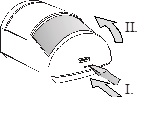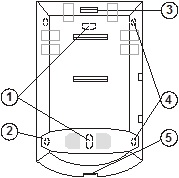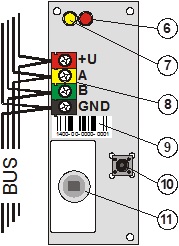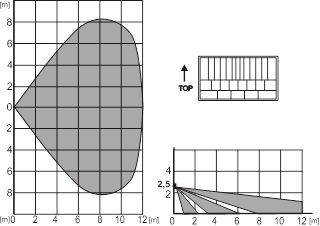Service note for JA-110P Wired PIR motion detector This product is a component of the JABLOTRON JA-100 alarm system. It provides motion detection of persons inside buildings. Its detection characteristics can be changed by using an alternative lens. Immunity against false alarms is optional, in two levels. The detector has...
JA-110P
Too much choice? Chat or call us at 085-0160316
There are no products in these categories. Shop on.

Service note for JA-110P
Wired PIR motion detector
This product is a component of the JABLOTRON JA-100 alarm system. It provides motion detection of persons inside buildings. Its detection characteristics can be changed by using an alternative lens. Immunity against false alarms is optional, in two levels. The detector has a pulse response (reports own activation only). The product is intended to be installed by a trained technician with a valid Jablotron certificate.
Installation
The detector can be installed on a wall or in a corner of the room. It is better if within its range there are no objects that change temperature quickly (electric heaters, gas appliances and the like), no moving objects (e.g. wavy curtains over a radiator) or pets. It is not recommended to install the detector opposite windows or reflectors, even where air flows (ventilation, air conditioning, draft holes, non-closing doors and the like). There must be no objects in front of the detector that obstruct the view.


Figure: 1 - holes for mounting on a flat wall; 2, 4 - holes for mounting in a corner; 3 - snap clip of the plate electronics; 5 - snap clip of the cover;
1. Open the cover of the detector (by pressing the snap clip 5). Do not touch the PIR sensor (11) inside - so as not to damage it.
2. Take out the electronics - it is attached to the snap clip 3.
3. Make holes in the plastic back panel for screws and cable. The recommended height for installing the detector is 2.5 m above the floor.
4. Pull the bus cable through and screw the plastic back panel in place (vertically, with the hood snap clip down).
For connecting the BUS, the system must be disconnected from the power supply.
5. Put back the electronics and connect the cable in the terminals (8).

Figure: 6 - red signal light of activation; 7 - yellow signal light of failure; 8 - terminals of the bus; 9 - serial number; 10 - tamper switch; 11 - PIR sensor;
6. Continue to follow the installation manual of the central unit. Basic steps:
a. After switching on, the yellow signal light (7) flashes because the detector is not assigned to the system.
b. In the F-Link programme on the Peripheral devices map, select the desired position and start learning mode with the Read button.
c. Press the tamper switch in the detector (10) - this will make the detector learn and the yellow signal light will go out. Note - the module occupies 2 consecutive positions (each input one).
7. Close the cover of the detector.
Set detector properties
This is done by the F-Link programme - peripherals card. At the position of the detector (first or second) select Internal settings. A dialogue appears, in which can be set:
Level immunity: determines the immunity against false alarms. By default (from the factory), basic immunity is combined with fast response. The Increased level provides better immunity, but the detector responds more slowly.
LED indication of movement: allows the indication of movement by the red LED to be switched off.
Detection characteristics
From the factory, the detector is equipped with a 110°/12m lens. The area is covered by 3 impellers (curtain fields) - see the following figure.

The characteristic can be changed by using an alternative lens:
JS-7904 is intended for long corridors, has a range of up to 20m
With this lens, the increased immunity cannot be used!
JS-7906 only has the upper range of 120°/12m and does not cover the floor (can eliminate movement of small animals across the floor)
JS-7901 vertical curtain field - does not cover the surface, but creates a detection wall (a barrier can be determined, any violation of it is reported)
Note: after replacing the lens, check that the detector covers the area properly (incorrectly installed lens may cause a detection error).
Technical parameters
Power supply from the BUS of the central unit 12 V (9 ... 15 V)
Current consumption at standby (idle) 5 mA
Current consumption for cable selection 5 mA
Recommended installation height 2,5 m above the floor
Detection angle/detection coverage 110° / 12 m (with base lens)
Dimensions 95 x 60 x 55 mm
Classification grade 2
compliant with CSN EN 50131-1, CSN EN 50131-2-2
Environment compliant with CSN EN 50131-1 II. indoor, general
Range of operating temperatures -10 to +40 °C
Further complies with CSN EN 50130-4, CSN EN 55022
Installation
The detector can be installed on a wall or in a corner of the room. It is better if within its range there are no objects that change temperature quickly (electric heaters, gas appliances and the like), no moving objects (e.g. wavy curtains over a radiator) or pets. It is not recommended to install the detector opposite windows or reflectors, even where air flows (ventilation, air conditioning, draft holes, non-closing doors and the like). There must be no objects in front of the detector that obstruct the view.


Figure: 1 - holes for mounting on a flat wall; 2, 4 - holes for mounting in a corner; 3 - snap clip of the plate electronics; 5 - snap clip of the cover;
1. Open the cover of the detector (by pressing the snap clip 5). Do not touch the PIR sensor (11) inside - so as not to damage it.
2. Take out the electronics - it is attached to the snap clip 3.
3. Make holes in the plastic back panel for screws and cable. The recommended height for installing the detector is 2.5 m above the floor.
4. Pull the bus cable through and screw the plastic back panel in place (vertically, with the hood snap clip down).
For connecting the BUS, the system must be disconnected from the power supply.
5. Put back the electronics and connect the cable in the terminals (8).

Figure: 6 - red signal light of activation; 7 - yellow signal light of failure; 8 - terminals of the bus; 9 - serial number; 10 - tamper switch; 11 - PIR sensor;
6. Continue to follow the installation manual of the central unit. Basic steps:
a. After switching on, the yellow signal light (7) flashes because the detector is not assigned to the system.
b. In the F-Link programme on the Peripheral devices map, select the desired position and start learning mode with the Read button.
c. Press the tamper switch in the detector (10) - this will make the detector learn and the yellow signal light will go out. Note - the module occupies 2 consecutive positions (each input one).
7. Close the cover of the detector.
Set detector properties
This is done by the F-Link programme - peripherals card. At the position of the detector (first or second) select Internal settings. A dialogue appears, in which can be set:
Level immunity: determines the immunity against false alarms. By default (from the factory), basic immunity is combined with fast response. The Increased level provides better immunity, but the detector responds more slowly.
LED indication of movement: allows the indication of movement by the red LED to be switched off.
Detection characteristics
From the factory, the detector is equipped with a 110°/12m lens. The area is covered by 3 impellers (curtain fields) - see the following figure.

The characteristic can be changed by using an alternative lens:
JS-7904 is intended for long corridors, has a range of up to 20m
With this lens, the increased immunity cannot be used!
JS-7906 only has the upper range of 120°/12m and does not cover the floor (can eliminate movement of small animals across the floor)
JS-7901 vertical curtain field - does not cover the surface, but creates a detection wall (a barrier can be determined, any violation of it is reported)
Note: after replacing the lens, check that the detector covers the area properly (incorrectly installed lens may cause a detection error).
Technical parameters
Power supply from the BUS of the central unit 12 V (9 ... 15 V)
Current consumption at standby (idle) 5 mA
Current consumption for cable selection 5 mA
Recommended installation height 2,5 m above the floor
Detection angle/detection coverage 110° / 12 m (with base lens)
Dimensions 95 x 60 x 55 mm
Classification grade 2
compliant with CSN EN 50131-1, CSN EN 50131-2-2
Environment compliant with CSN EN 50131-1 II. indoor, general
Range of operating temperatures -10 to +40 °C
Further complies with CSN EN 50130-4, CSN EN 55022
